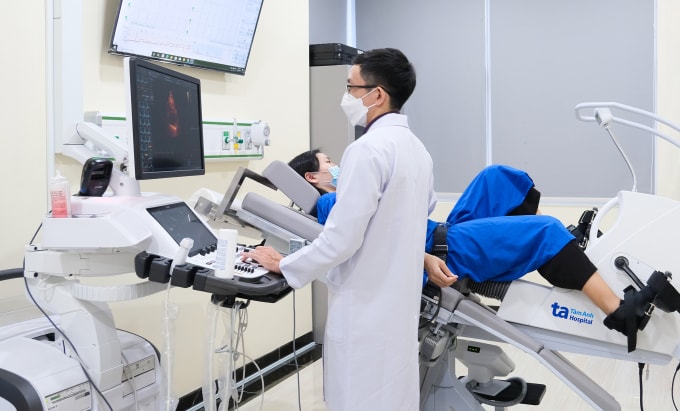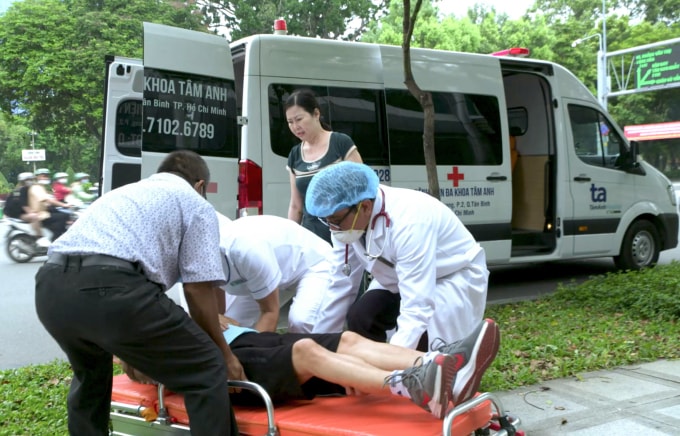Young people are screened for myocardial infarction risk using stress echocardiography.
Professor, Doctor Vo Thanh Nhan, Director of the Interventional Cardiology Center at Tam Anh General Hospital in Ho Chi Minh City, provided this information, adding that within 30 minutes of the heart being deprived of blood, the myocardial structure changes and edema occurs, and after 3 hours of ischemia, myocardial cells die. At this point, the heart is weak and unable to adequately reperfuse tissues and organs.
Acute myocardial infarction is caused by atherosclerosis. This atherosclerotic plaque ruptures suddenly, activating clotting factors in the plasma to form a blood clot that blocks the blood vessel, completely preventing blood flow to the heart. The plaque forms silently in the body, without warning signs, thereby damaging blood vessels and the heart, gradually leading to atherosclerosis and events such as myocardial infarction. "If not treated promptly, the risk of death is 40%, with 20% due to arrhythmias in the first few hours," Professor Nhan said, adding that even if the patient survives, extensive myocardial necrosis can lead to heart failure, affecting their quality of life and reducing their life expectancy.
According to statistics from the World Health Organization (WHO), approximately 17.5 million people die globally each year from cardiovascular diseases, with myocardial infarction (heart attack) being the most urgent condition; without timely treatment, the risk of death can reach 50%. In Vietnam, around 200,000 people die annually from cardiovascular diseases, with myocardial infarction being the majority.
According to Professor Nhan, while improved emergency measures for myocardial infarction allow for rapid intervention, treatment remains challenging due to the sudden onset of symptoms and the late arrival of patients. The "golden" time for treatment is 1-2 hours after the onset of angina symptoms, or at least within the first 6 hours, when intervention is needed to recanalize the blocked arterial branch to increase blood flow to the heart, reduce the extent of myocardial necrosis, heart failure, and subsequent arrhythmias.
Individuals at risk of myocardial infarction may experience symptoms such as left-sided chest pain or pain behind the sternum. The pain typically lasts more than 20 minutes and may radiate to the neck, chin, shoulders, back, right arm, or epigastric region. Other symptoms include palpitations, shortness of breath, cold sweats, fatigue, nausea, and altered consciousness. According to Professor Nhan, approximately half of cases have no warning signs and only occur during excessive exertion such as high-intensity sports training, uncontrolled emotions, sudden or unexpected situations, or psychological stress.
Proper timing and initial first aid before reaching the hospital significantly increase the chances of survival and reduce long-term complications for the patient. If experiencing symptoms like those described above, the patient should remain calm, immediately stop all activity, find the nearest place to sit or lie down in a semi-sitting position, and loosen clothing to alleviate shortness of breath and fatigue. Note that strenuous activity should be avoided at this time as it can worsen damage to the heart muscle. Afterward, the patient should quickly contact the 115 emergency service or ask a family member to take them to the nearest hospital or a facility with adequate emergency care and intervention for myocardial infarction.
The pre-hospital emergency team provides first aid to a patient with acute myocardial infarction before transferring them to the hospital.
Currently, there are three basic techniques for emergency treatment of myocardial infarction: medication, stenting, and surgery. In medical centers lacking the facilities for stenting, thrombolytic therapy may be used as a measure to prolong the emergency treatment period. Even with successful intervention, patients must still take prescribed medication, follow a treatment plan, manage underlying conditions, undergo long-term follow-up examinations, and make lifestyle changes.
According to Assoc. Prof. Dr. Nguyen Thi Bach Yen, Head of the Cardiology Department at Tam Anh General Hospital in Hanoi , about 20-30 years ago, cardiovascular disease deaths were often due to rheumatic heart valve disease (rheumatic heart disease). While this group of diseases has decreased, new diseases related to atherosclerosis have emerged due to modern lifestyles. Every day, the Cardiology Center of the Tam Anh General Hospital system receives approximately 10 patients with myocardial infarction. Of these, one-third are men over 40 years old, overweight or obese, with dyslipidemia, hypertension, diabetes, heavy smoking, late nights, sedentary lifestyles, and stressful lives.
Young people with modern lifestyles, lack of exercise, unhealthy diets, consumption of fast food, smoking, and substance abuse are all silent risk factors that contribute to myocardial infarction. Individuals with untreated or poorly controlled hypertension, diabetes, or dyslipidemia may also have an increased risk of developing the disease. Those with a family history of dyslipidemia, a father or uncle who had a myocardial infarction before age 55, or a mother who had a myocardial infarction before age 65 should undergo regular cardiovascular health screenings.
LA (compiled)
Source: https://baohaiduong.vn/nhoi-mau-co-tim-nguy-hiem-the-nao-410378.html








![[Photo] Prime Minister Pham Minh Chinh presides over a meeting on private sector economic development.](/_next/image?url=https%3A%2F%2Fvphoto.vietnam.vn%2Fthumb%2F1200x675%2Fvietnam%2Fresource%2FIMAGE%2F2025%2F12%2F20%2F1766237501876_thiet-ke-chua-co-ten-40-png.webp&w=3840&q=75)






























































































Comment (0)